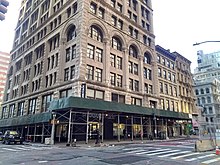Mutual Reserve Building
The 13-story building, constructed between 1892 and 1894, was designed by William H. Hume and built by Richard Deeves, with Frederick H. Kindl as chief structural engineer.
The Mutual Reserve Building was designed in a variant of the Romanesque Revival style inspired by the work of Henry Hobson Richardson.
The building's articulation consists of three horizontal sections similar to the components of a column, namely a base, shaft, and capital.
The facade is clad with granite and limestone, and includes arcades on its lower and upper stories, piers made of rusticated stone blocks, and decorative foliate motifs.
After the Mutual Reserve Association went bankrupt in 1909, 305 Broadway was renamed the Langdon Building, after the son of the owner.
[4] It was designed by William H. Hume in a variant of the Romanesque Revival style inspired by the work of Henry Hobson Richardson.
[6][7] The eastern and southern facades are clad in limestone and divided into three horizontal sections: a base and shaft of six stories each, as well as a one-story capital.
[5][11] The Mutual Reserve Building utilized steel in its beams and columns, which were riveted to each other and supported each floor's walls.
[5][12][13] In 1909, during a meeting of the Institution of Civil Engineers, Carnegie Steel engineer C. V. Childs stated that he had devised a wind bracing system, using gusset plates at the building's narrow end to reduce distortion; this system was first used in either the Mutual Reserve Building or the Savoy-Plaza Hotel.
The first floor is reserved for retail space, and was placed at ground level, as opposed to earlier buildings that had a raised basement for their first-floor tenants.
[20] William Fletcher Weld, who died in 1881, was described as one of the most successful merchant ship owners in the United States.
[7] On June 14, 1894, two hundred guests and Mutual Reserve employees attended dedication ceremonies on the building's roof.
[7][16] In the first two decades of the Mutual Reserve Building's existence, it contained the offices of several tenants involved in the paper and publishing industry.
Additional tenants included the Co-Operative Building Bank, the Spanish Benevolent Society of New York, the Mutual Mercantile Agency, the Miller Bros Cutlery Company, and a "National Organization of Brain Brokers" named Hapgoods.
[7] The Weld estate retained ownership of the building, although William Jr. died in 1893 and Charles and Isabel gave up their respective shares in 1901 and 1907.
[39] The building was probably named after John Langdon Brandegee, a stock broker who was the son of the sole owner at the time, Mary Bryant Pratt Sprague.
[41] The purchase was due to the building's proximity to courthouses on Chambers Street and the lack of available space for lawyers in the Financial District.
[42][43] In 1923, architects Schwartz & Gross were hired to replace the large entrance arch on Broadway with a "squared-off" opening.
[7][32] The Mutual Reserve Building was not highly regarded in the legal sector, being described as "a law office slum"[32][44] and a 1920s hub of the "personal injury underworld".
[32][45] Other tenants during that time included metal supplier Herman J. Heght Inc.; the Amalgamated Lithographers of America; architecture firm Marcus Contracting Company; architect George F. Hardy;[7][46] and a temporary location of the Wall Street Synagogue.
[27] The same year, the New-York Tribune wrote that the Mutual Reserve Building's design "has aroused the admiration of all who have seen it.
"[8][16] The building's fireproof features were inspected in an 1895 visit led by William Hume and managing director G. H. Wooster, leading The New York Times to state that "[m]odern scientific construction can go no further".

